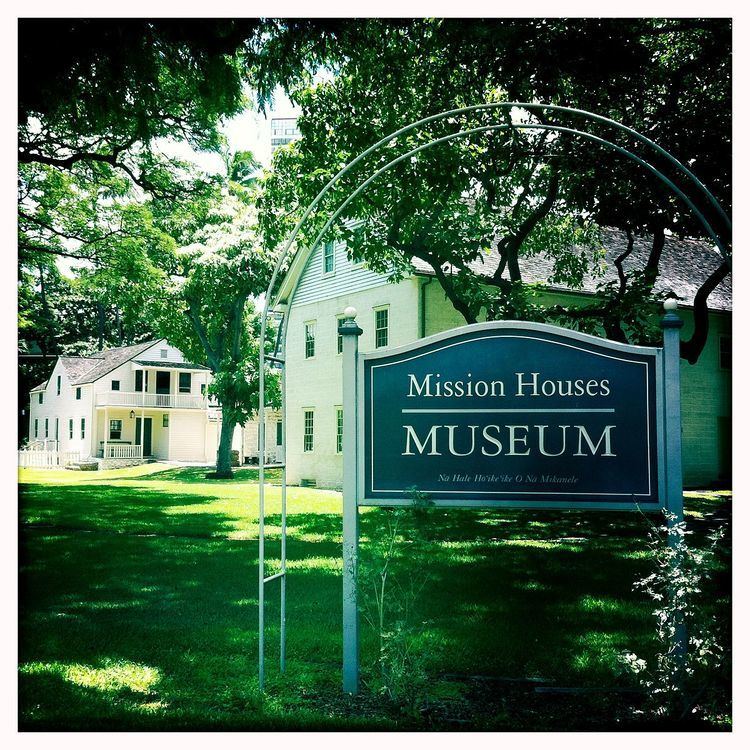Established 1920 | Phone +1 808-531-0481 | |
 | ||
Location 553 South King Street, Honolulu, Hawaii Address 553 S King St, Honolulu, HI 96813, USA Hours Closed now Friday10AM–4PMSaturday10AM–4PMSundayClosedMondayClosedTuesday10AM–4PMWednesday10AM–4PMThursday10AM–4PM Similar Kawaiahao Church and Missi, ʻIolani Palace, Hānaiakamalama, Bishop Museum, Aliiolani Hale Profiles | ||
Hawaiian mission houses historic site and archives
The Hawaiian Mission Houses Historic Site and Archives Honolulu, Hawaii, was established in 1920 by the Hawaiian Mission Children’s Society, a private, non-profit organization and genealogical society, on the 100th anniversary of the arrival of the first Christian missionaries in Hawaiʻi. In 1962, the Mission Houses, together with Kawaiahaʻo Church, both built by those early missionaries, were designated a U.S. National Historic Landmark (NHL) under the combined name Kawaiahao Church and Mission Houses. In 1966 all the NHLs were included in the National Register of Historic Places.
Contents
- Hawaiian mission houses historic site and archives
- The hawaiian mission houses historic site and archives digital collection
- Houses
- Oldest Frame House
- Chamberlain House
- Print House
- References
The Hawaiian Mission Houses Historic Site and Archives collects, preserves, interprets, and exhibits documents, artifacts, and other records of Hawaii’s “missionary” period from about 1820 to 1863. It interprets its historic site and collections and makes these collections available for research, educational purposes, and public enjoyment. The archive’s collection holds over 3,000 Hawaiian, Western, and Pacific artifacts, and more than 12,000 books, manuscripts, original letters, diaries, journals, illustrations and Hawaiian church records. The historic site and archive is open Tuesday through Saturday from 10:00 a.m. to 4:00 p.m. The general admission charge is $10, with discounts for students, seniors, and the military.
The hawaiian mission houses historic site and archives digital collection
Houses
The evolution of Mission House architecture illustrates the progressive adaptation of missionaries from New England to the climate, culture, and building materials they encountered in the Sandwich Islands.
Oldest Frame House
The materials to build the Oldest Frame House (Ka Hale Lāʻau ‘the wood house’) arrived by ship around Cape Horn from Boston in 1821. They had already been measured and cut, ready to assemble into a frame house suitable for the climate of New England: with small windows to help keep the heat inside and short eaves so as not to risk cracking under a load of snow.
Though principally occupied by the seven members of Daniel Chamberlain's family, it often housed as many as five other missionary families, along with occasional ailing sailors or orphans. The small parlor served as a schoolhouse, and the basement served as the dining hall. The cookhouse was a separate building.
Chamberlain House
The Chamberlain House (Ka Hale Kamalani) was built in 1831 from materials procured locally: coral blocks cut from reefs offshore and lumber salvaged from ships. Designed by the mission's quartermaster, Levi Chamberlain, to hold supplies as well as people, it had two stories, an attic, and a cellar. The windows are larger, more numerous, and shuttered against the sun. The building now serves as the main exhibition hall for the Museum.
Print House
In 1841, a covered porch and balcony were added to the frame house, and an extra bedroom was built next door out of coral blocks. Both additions show further adaptation to an indoor-outdoor lifestyle appropriate to the climate. The extra coral building later became the mission's Print House (Ka Hale Paʻi) and now serves as a museum exhibit to show how the missionaries and native Hawaiians worked together to produce the first materials printed in the Hawaiian language.
